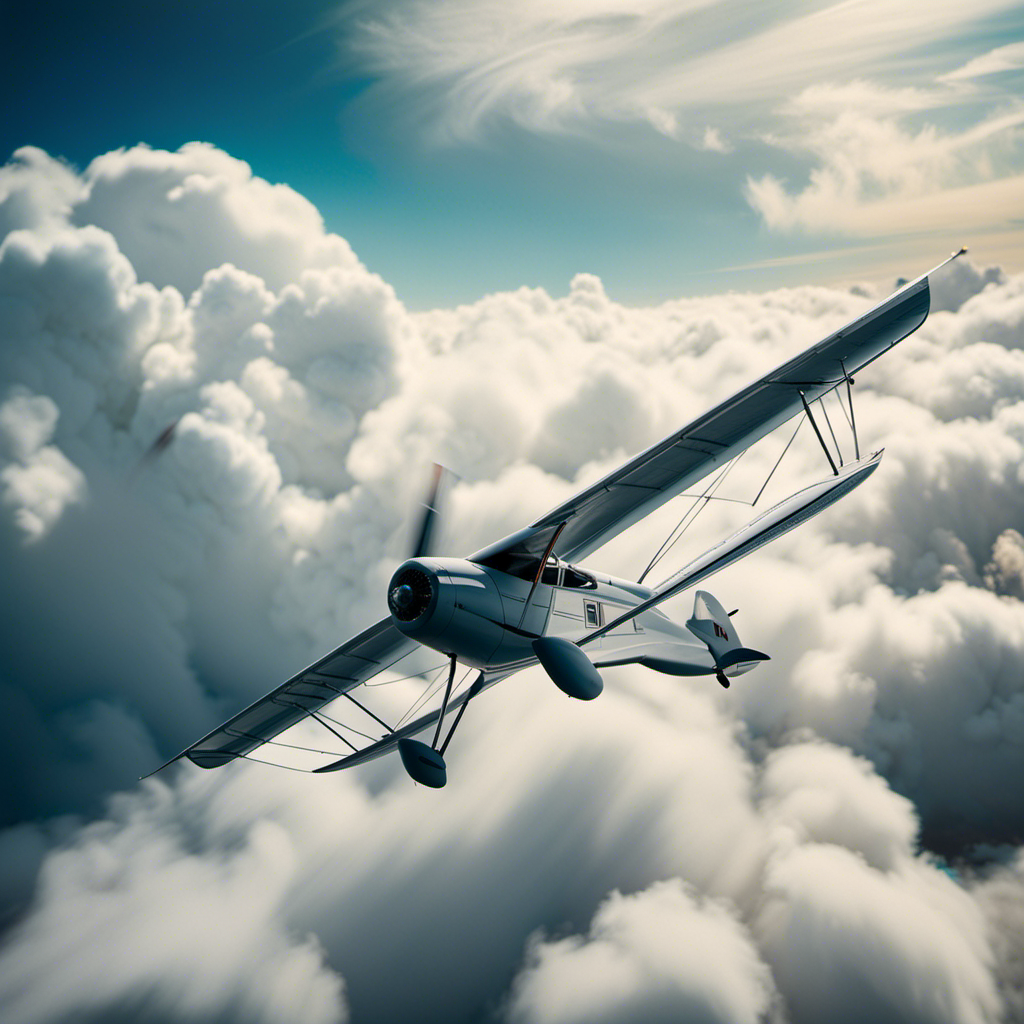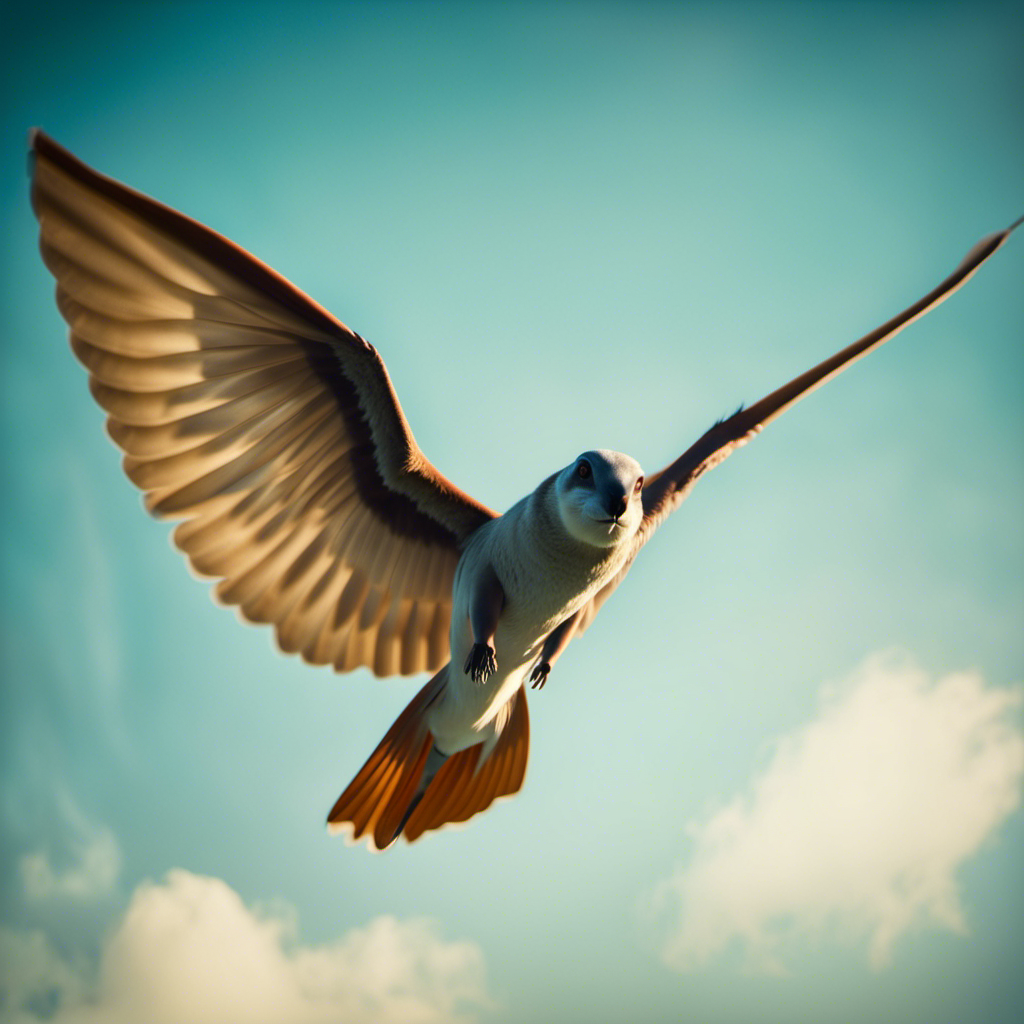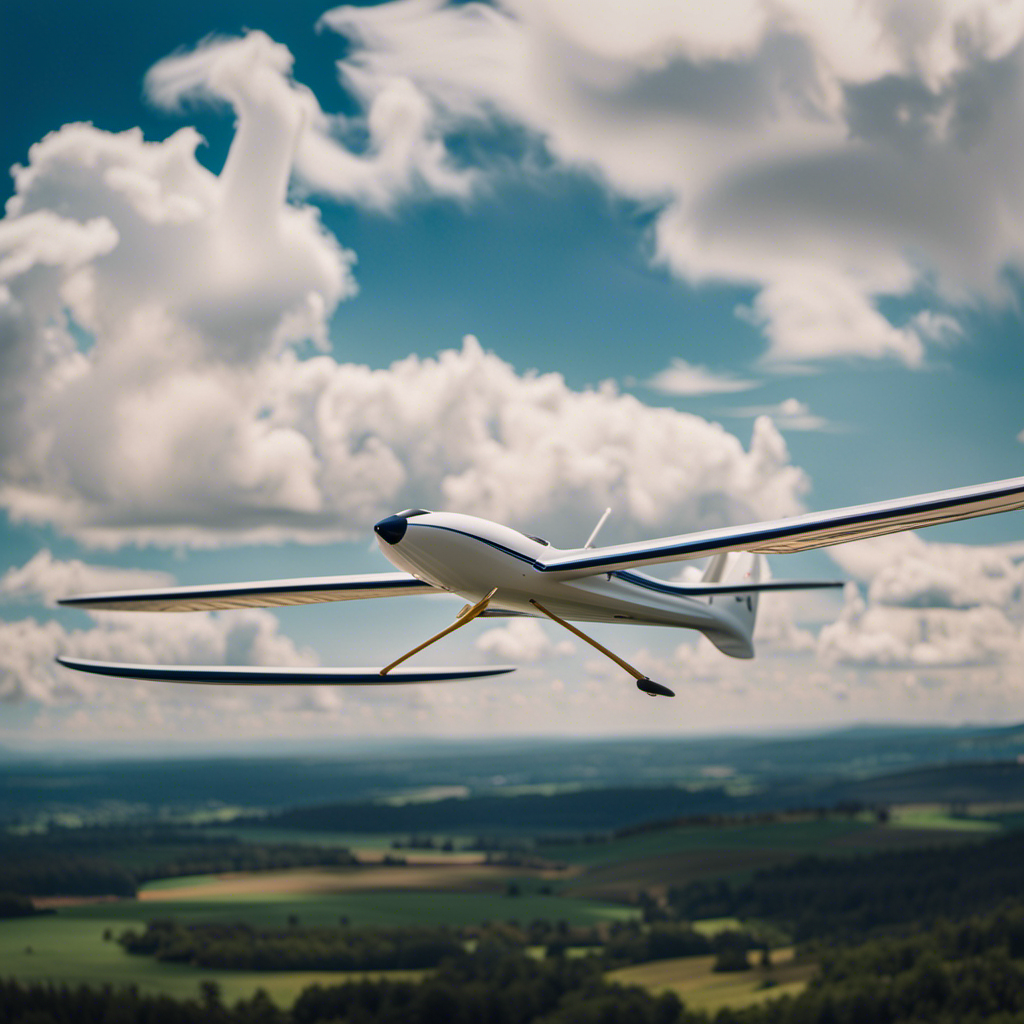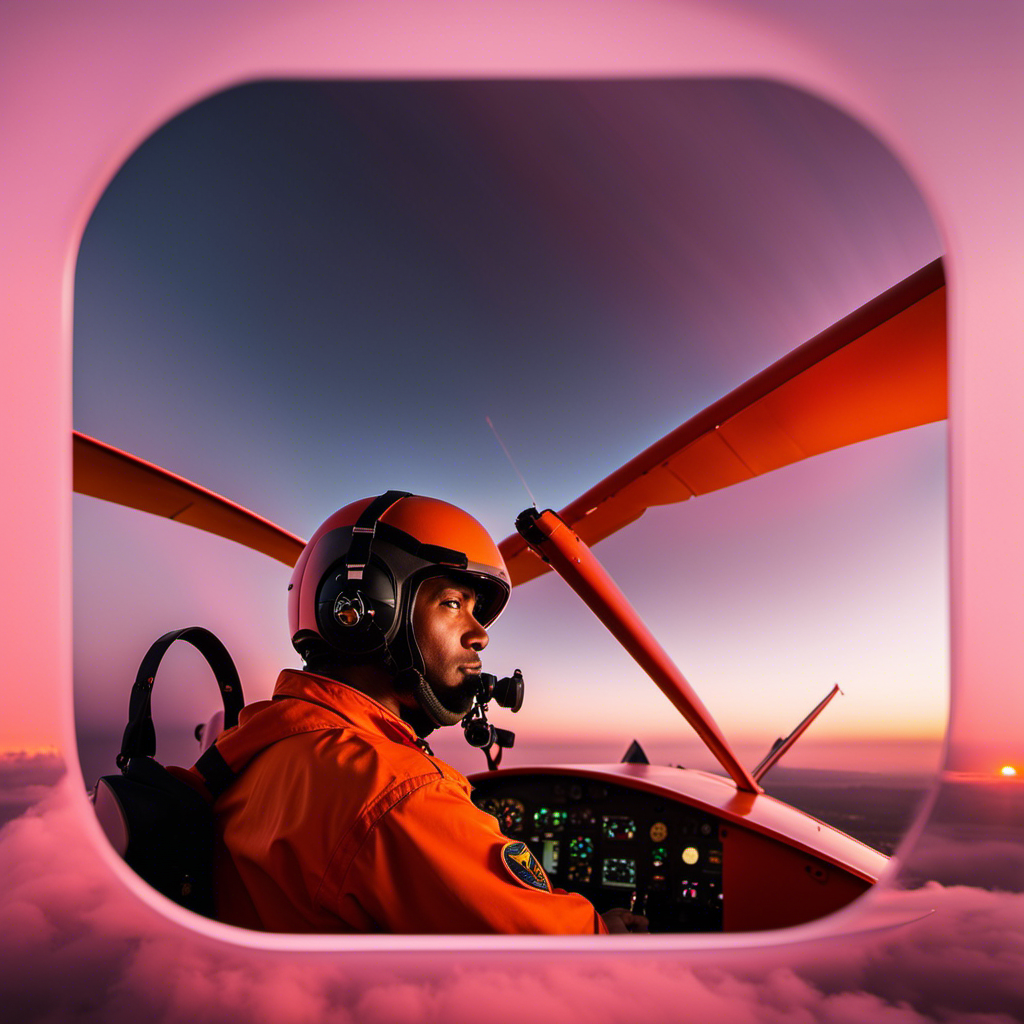As I soar through the skies, I experience the thrilling sensation of the wind on my face and the liberation of flying amidst the clouds. Gliding has introduced me to a whole new realm of excitement, and if you are eager to take flight and master the art of gliding, then this article is just for you.
In this guide, I will walk you through what to expect from gliding lessons, from safety precautions to mastering advanced gliding skills.
Get ready to experience the thrill of gliding like never before.
Key Takeaways
- Gliding is flying without an engine, relying on natural forces for flight.
- Understanding weather conditions, including wind direction and thermal activity, is crucial for gliding.
- Conduct thorough pre-flight checks and prioritize safety at all times.
- Choose a reputable gliding school for a quality learning experience.
What is Gliding?
Gliding is a type of flying where the aircraft does not have an engine. Instead, it relies on natural forces to stay airborne. Soaring techniques play a crucial role in gliding, as pilots use them to gain altitude and extend their flights.
Understanding weather conditions is also essential in gliding. We have to assess wind direction, speed, and thermal activity to plan our flights effectively. Thermals, which are columns of rising warm air, are particularly important for gliders. They can provide the necessary lift to keep the aircraft flying for extended periods. It is crucial to study weather patterns and learn how they affect gliding conditions.
By mastering these techniques and understanding weather conditions, we can optimize our gliding experiences and make the most of our flights.
When it comes to safety precautions, there are several measures we must take to ensure a secure and enjoyable gliding experience.
Safety Precautions
As a glider pilot, I must prioritize safety at all times. This discussion will focus on three key aspects of safety in gliding:
-
The importance of conducting thorough pre-flight checks. These checks are crucial to ensure that the glider is in proper working condition before taking off. They involve inspecting various components such as the wings, control surfaces, and instrumentation. By thoroughly checking the glider before every flight, I can identify any potential issues and address them before they become a safety hazard.
-
The significance of understanding weather conditions for safe flying. Weather plays a critical role in gliding, as it can greatly impact the flight performance and safety of the glider. It is essential for me to have a good understanding of weather patterns, including wind speed and direction, temperature, and cloud formations. By being aware of the weather conditions, I can make informed decisions about when it is safe to fly and when it is necessary to postpone or cancel a flight.
-
The necessary emergency procedures to handle unforeseen situations. Despite thorough pre-flight checks and careful consideration of weather conditions, emergencies can still occur during a gliding flight. It is essential for me to be prepared and knowledgeable about the appropriate emergency procedures, such as how to handle a sudden loss of altitude or how to land safely in an emergency landing zone. By being prepared for these situations, I can effectively respond and minimize the risks associated with emergencies.
Importance of Pre-Flight Checks
Before taking off, it’s crucial to perform pre-flight checks to ensure a safe gliding experience. These checks are essential to identify any potential issues that could compromise the flight.
Here are some key points to consider:
- Inspect the aircraft’s exterior for any visible damage or loose parts.
- Check the fuel level and ensure it is sufficient for the planned flight duration.
- Examine the control surfaces to make sure they move freely and are not obstructed.
- Verify the functionality of the instruments, including altimeter, airspeed indicator, and variometer.
- Confirm that the parachute is securely fastened and accessible.
By conducting these pre-flight checks, you can mitigate common errors such as missing or faulty equipment, which could lead to accidents or emergencies during the gliding session.
Now, let’s move on to understanding weather conditions for gliding, as it is another crucial aspect of ensuring a safe and enjoyable experience.
Understanding Weather Conditions for Gliding
Checking the weather forecast is essential for a safe and enjoyable gliding experience. Understanding thermals and updrafts is crucial when it comes to choosing the right conditions for gliding.
Thermals are columns of warm air that rise from the ground due to heating from the sun. These upward currents can provide the glider with the necessary lift to stay airborne.
Updrafts, on the other hand, are created by wind blowing against a slope or ridge. Utilizing ridge lift involves flying close to the slope, where the wind is deflected upwards, generating lift. Wave lift is another technique, which occurs when wind encounters a mountain range and creates a series of standing waves in the air. These waves can provide extended periods of lift.
Understanding these weather phenomena is essential for planning your gliding adventure.
Now, let’s move on to emergency procedures, in case unexpected situations arise during your flight.
Emergency Procedures
If an unexpected situation arises during your flight, you’ll need to know the emergency procedures. Being prepared for emergencies is crucial when gliding. Here are three important things to keep in mind:
-
Emergency Landing: In the event of a problem with the aircraft, the pilot must be able to quickly identify a suitable landing spot. This could be a designated airstrip, a field, or any open area that allows for a safe landing.
-
Emergency Equipment: Glider aircraft are equipped with emergency equipment to ensure the safety of the pilot and passengers. This includes items such as parachutes, fire extinguishers, and emergency locator transmitters (ELTs) to aid in rescue operations.
-
Communication: Maintaining clear communication with air traffic control and other pilots is essential during emergencies. Availing yourself of the proper radio frequencies and using the correct terminology can help ensure that you receive the necessary assistance and guidance.
Understanding these emergency procedures and being prepared for unexpected situations is essential for a safe gliding experience. Now, let’s delve into the exciting world of getting started with gliding lessons.
Getting Started with Gliding Lessons
When embarking on the journey of learning to glide, it’s essential to start with a reputable gliding school. I will discuss the key points of finding such a school, including considering their safety record, instructor qualifications, and equipment maintenance.
Additionally, I will provide guidance on what to bring to your first lesson, ensuring you have the necessary items for a successful experience.
Finding a Reputable Gliding School
You’ll want to look for a reputable gliding school before starting your lessons. Finding a gliding school can be overwhelming, but there are a few key factors to consider.
First, seek recommendations from experienced gliders or aviation enthusiasts in your area. They can provide valuable insights on the best schools to consider. Additionally, do some online research to find schools that have positive reviews and a good track record. Look for schools that have certified instructors, well-maintained gliders, and a strong emphasis on safety. It’s also important to consider the location and facilities offered by the school.
Once you have found a reputable gliding school, you’ll be ready to take the next step and prepare for your first lesson.
Transition: Now that you have found a reputable gliding school, let’s talk about what you should bring to your first lesson.
What to Bring to Your First Lesson
Now that you’ve found a reputable gliding school, let’s discuss what you should bring to your first lesson. Being prepared will ensure a smooth and enjoyable experience. Here are three essential items you should bring:
-
Proper attire: Wear comfortable clothing, preferably made of breathable materials. Dress in layers, as the temperature may change during the flight. Avoid loose accessories that may get caught in the equipment.
-
Essential equipment: It’s important to bring a few key items with you. These include a sturdy pair of shoes with good traction for walking on the airfield, sunglasses to protect your eyes from the sun, and sunscreen to shield your skin from harmful UV rays.
-
Water and snacks: Gliding can be physically demanding, so it’s crucial to stay hydrated and energized. Bring a water bottle and some light snacks to keep your energy levels up throughout the lesson.
Meeting Your Instructor and Getting Familiar with the Glider
As you meet your instructor, they will guide you through the process of getting familiar with the glider. This initial meeting is crucial in establishing a strong foundation for your gliding lessons.
Your instructor will introduce you to the different components of the glider, such as the wings, control surfaces, and cockpit instruments. They will explain their functions and how they contribute to the overall flight experience.
You will also learn about the pre-flight checks and safety procedures that must be followed before every flight. Familiarizing yourself with the glider will help you understand its capabilities and limitations, ensuring a safe and successful learning experience.
Now that you have a basic understanding of the glider, let’s move on to learning how to control it effectively.
Learning to Control the Glider
When you first start learning to control the glider, it may feel a bit overwhelming, but with practice, you’ll become more comfortable and confident. To help you on your journey to mastering the art of gliding, here are some essential controlling techniques and maneuvers to focus on:
-
Weight Shift: By shifting your body weight, you can control the direction and bank angle of the glider. Lean towards the side you want to turn, and the glider will respond accordingly.
-
Rudder Input: The rudder pedals control the yaw of the glider. By applying pressure with your feet, you can coordinate turns and maintain proper alignment with the wind.
-
Elevator Control: Use the control stick or yoke to adjust the pitch of the glider. Pulling back raises the nose, while pushing forward lowers it.
As you become proficient in these controlling techniques and develop a sense of the glider’s responsiveness, you’ll be ready to explore the exciting world of soaring techniques without delay.
Soaring Techniques
When it comes to soaring techniques, there are several key points to consider.
First, utilizing thermals and updrafts is crucial for gaining altitude and staying aloft. These natural phenomena can be detected and harnessed to maximize glider performance.
Additionally, ridge and wave lift are important factors to understand, as they can provide sustained lift along mountainous terrain or in specific wind patterns.
Utilizing Thermals and Updrafts
You can expect to utilize thermals and updrafts during your gliding lessons. Thermals and updrafts are two different types of air currents that can provide lift for a glider. Understanding the characteristics and differences between thermals and updrafts is essential for maximizing lift potential and extending your gliding time.
Thermals are columns of warm air that rise from the Earth’s surface. They are created by the uneven heating of the ground and can be identified by the presence of cumulus clouds. Thermals are typically narrower and stronger than updrafts, offering a more powerful lift for gliders.
On the other hand, updrafts are horizontal air currents that are formed when wind encounters an obstacle, such as a hill or a mountain. Updrafts are generally broader and less intense than thermals but can still provide a significant amount of lift for gliders.
To compare thermals and updrafts in terms of maximizing lift potential, consider the following table:
| Thermals | Updrafts |
|---|---|
| Narrow and strong | Broader and less intense |
| Created by uneven heating of the ground | Formed by wind encountering an obstacle |
| Identified by the presence of cumulus clouds | No cloud formation |
Ridge and Wave Lift
Ridge lift and wave lift can be advantageous for gliders in certain geographical areas.
Ridge lift occurs when the wind encounters an obstacle, such as a mountain range, and is forced to rise. As the air rises, it creates an upward lift force that gliders can utilize to gain altitude.
Wave lift, on the other hand, is caused by the interaction between the wind and the atmosphere. When a stable layer of air encounters a mountain range, it can create a series of standing waves. Gliders can ride these waves, much like surfing, to gain altitude and stay aloft for extended periods.
Understanding the characteristics of ridge and wave lift is crucial for glider pilots, as it allows them to plan their flights and take advantage of these natural phenomena.
Now, let’s explore strategies for staying aloft and gaining altitude without relying solely on thermals.
Strategies for Staying Aloft and Gaining Altitude
After learning about the fascinating phenomena of ridge and wave lift, it is time to delve into the strategies for staying aloft and gaining altitude during gliding lessons.
When soaring through the skies, it is crucial to stay focused and maintain a calm demeanor. By staying focused, pilots can anticipate changes in wind patterns and adjust their flight path accordingly. This involves constantly scanning the surrounding environment for visual cues that indicate areas of lift or sink.
Additionally, staying calm is essential to make rational decisions and react effectively to unexpected situations. By remaining composed, pilots can avoid panic and think clearly, ensuring a safe and controlled flight.
Now, let’s transition to the next section, where we will explore the art of navigation and cross-country gliding, which involves the use of various techniques to navigate long distances in a glider.
Navigation and Cross-Country Gliding
When it comes to navigation and cross-country flying, there are several key points to keep in mind.
First, understanding how to read aviation charts and navigate using various instruments is crucial for a successful flight.
Second, planning and executing cross-country flights requires careful consideration of factors such as weather conditions, airspace restrictions, and navigation waypoints.
Lastly, when flying long distances, it’s important to have tips and strategies in place to ensure a safe and efficient journey.
Reading Aviation Charts and Navigation Instruments
You’ll need to familiarize yourself with reading aviation charts and using navigation instruments during your gliding lessons.
Reading charts is essential for understanding airspace restrictions, terrain features, and navigation aids. It involves interpreting symbols, colors, and lines to determine your position and plan your route.
Navigation instruments play a crucial role in guiding your glider. The variometer measures the rate of climb or descent, helping you find thermals for lift. The compass provides direction, while the altimeter shows your altitude above sea level. Additionally, the GPS receiver can give you accurate position information and help you navigate to specific waypoints.
Mastering these skills will prepare you for planning and executing cross-country flights, where you can explore new areas and challenge your gliding abilities.
Planning and Executing Cross-Country Flights
To plan and execute cross-country flights successfully, familiarize yourself with navigation charts and utilize your navigation instruments. Here are four essential navigation techniques for planning routes:
-
Study sectional charts: These charts provide detailed information about airspace, airports, landmarks, and obstacles along your route. Understanding how to interpret them is crucial for identifying suitable checkpoints and avoiding restricted areas.
-
Use VOR navigation: Very High Frequency Omnidirectional Range (VOR) stations transmit signals that help you navigate between waypoints. By tuning in to the correct frequency and tracking the radial, you can establish your position and stay on course.
-
Plan for wind correction: Wind can significantly affect your track. To compensate for this, calculate the wind direction and speed, and adjust your heading accordingly. This ensures you stay on the intended route.
-
Consider alternate airports: Always have backup airports in mind in case of emergencies or unexpected weather conditions. Knowing their locations and communication frequencies can be vital in critical situations.
By mastering these navigation techniques and effectively planning your routes, you can enhance the safety and efficiency of your cross-country flights.
Now, let’s explore some helpful tips for flying long distances.
Tips for Flying Long Distances
After mastering the art of planning and executing cross-country flights, it is essential to acquire the skills necessary for flying long distances.
Flying long distances requires a different set of techniques to ensure efficiency and safety. Firstly, it is crucial to maintain an optimal altitude, taking advantage of thermals and ridge lift to stay airborne for extended periods.
Additionally, proper equipment maintenance is vital to avoid any potential issues during long flights. Regular inspections and servicing of the glider, including checking the control surfaces, airframe, and instruments, will help prevent any unexpected malfunctions.
By implementing these flying techniques and prioritizing equipment maintenance, one can confidently embark on long-distance gliding adventures, exploring new horizons and discovering the true essence of gliding.
Now, let’s delve into the realm of advanced gliding skills, where we further hone our expertise in the art of soaring.
Advanced Gliding Skills
When it comes to advanced gliding skills, there are three key areas that I find particularly intriguing.
Firstly, aerobatic maneuvers in gliders require precise control and coordination, pushing the limits of both pilot and aircraft.
Secondly, speed and performance optimization involves finding the most efficient ways to maximize speed and minimize drag, allowing for faster and more exhilarating flights.
Lastly, competing in gliding competitions adds an element of strategy and precision, as pilots strive to achieve the highest scores and outperform their competitors.
Aerobatic Maneuvers in Gliders
Gliders can perform exhilarating aerobatic maneuvers, such as loops and rolls. These advanced techniques require precise control and understanding of the glider’s capabilities.
Aerobatics in gliders involve intentionally maneuvering the aircraft in ways that go beyond normal flight. During loops, the glider climbs vertically, creating a circular path in the sky. Rolls involve rotating the glider along its longitudinal axis. These maneuvers require careful coordination of control inputs and a deep understanding of the aerodynamics involved.
Proper training and experience are crucial to ensure safety and proficiency when performing aerobatic maneuvers in gliders. Mastering these techniques can enhance your flying skills and provide a thrilling experience.
Transitioning into the next section, speed and performance optimization, we will explore how to maximize the glider’s capabilities for efficient and high-performance flights.
Speed and Performance Optimization
To maximize your glider’s speed and performance, you’ll need to make adjustments to its design and configuration.
Glider design plays a crucial role in determining its aerodynamic efficiency. By reducing drag and optimizing lift, you can achieve higher speeds and better overall performance.
One important aspect of glider design is the wingspan. A longer wingspan allows for greater lift and improved glide ratio.
Additionally, the wing shape and airfoil design can greatly influence the glider’s performance in different wind patterns. For example, a glider with a higher cambered airfoil is better suited for flying in light winds, while a thinner airfoil is more efficient in high-speed conditions.
By understanding these design principles and considering the wind patterns you’ll encounter, you can make informed adjustments to your glider and optimize its speed and performance.
Transitioning into competing in gliding competitions, it’s essential to have a well-optimized glider to give you an edge over the competition.
Competing in Gliding Competitions
If you want to compete in gliding competitions, it’s important to have a well-optimized glider that gives you an edge over the competition. Gliding techniques and equipment play a crucial role in achieving success in these competitions.
When it comes to gliding techniques, it’s important to master advanced skills such as thermaling, ridge soaring, and cross-country navigation. These techniques allow you to maximize your glider’s performance and cover long distances efficiently.
Additionally, having the right gliding equipment is essential. This includes selecting the appropriate wing profile, weight distribution, and control surfaces. Optimizing these factors can significantly enhance your glider’s speed and maneuverability.
By implementing these gliding techniques and using the right equipment, you can increase your chances of winning in gliding competitions.
Now, let’s move on to gliding etiquette and safety tips, where we’ll discuss how to ensure a safe and enjoyable gliding experience.
Gliding Etiquette and Safety Tips
Remember, it’s important to follow gliding etiquette and safety tips to ensure a smooth and enjoyable experience.
When it comes to gliding communication, clear and concise radio transmissions are crucial. Pilots should use standard phraseology and avoid unnecessary chatter to maintain effective communication with other gliders and air traffic control.
Additionally, emergency landing techniques should be practiced and understood. In the event of an emergency, pilots must remain calm and follow established procedures for a safe landing.
It’s also important to be aware of airspace restrictions and respect other gliders’ right of way. By adhering to these guidelines, we can create a safe and harmonious gliding environment.
Now, let’s move on to the next section and discuss the challenges one may encounter in gliding.
Overcoming Challenges in Gliding
Be prepared for the various challenges you may face during gliding, such as unpredictable weather conditions and maintaining control in turbulent air. Overcoming fear and building confidence are essential in conquering these challenges.
Fear of heights or the fear of being in control can be daunting, but with proper training and guidance, you can overcome these obstacles. Learning to trust yourself and your abilities is crucial in gliding. As you gain experience and become more comfortable, your confidence will grow.
It is important to remember that fear is natural, but with each successful flight, you will build confidence and overcome your fears.
Now, let’s explore the thrill of gliding, where every flight brings a new adventure and a sense of freedom.
The Thrill of Gliding
Get ready to experience the exhilarating thrill of gliding as you soar through the sky and feel the rush of freedom with each new adventure. Gliding is an incredible sport that combines the adrenaline rush of flying with the skill and precision of mastering gliding techniques.
Here are three things you can expect when diving into the world of gliding:
-
Adrenaline Rush: As you launch into the air, the adrenaline will surge through your veins, heightening your senses and filling you with a sense of exhilaration like no other. The feeling of flying without an engine is truly unmatched.
-
Mastering Gliding Techniques: Gliding isn’t just about soaring through the sky; it requires a deep understanding of aerodynamics, weather conditions, and navigation. You will learn how to read the wind, control the glider, and make precise adjustments to maintain your altitude and speed.
-
Freedom and Serenity: Gliding offers a unique sense of freedom and serenity. As you glide through the air, you’ll feel a profound connection to nature and a peacefulness that comes from being completely in harmony with the elements.
Frequently Asked Questions
What are the physical requirements to learn how to glide?
To learn how to glide, physical fitness is important. Health considerations should also be taken into account. It is necessary to have a certain level of physical ability and stamina to safely participate in gliding lessons.
How long does it typically take to become proficient in gliding?
On average, it takes about 50-70 hours of instruction and practice to become proficient in gliding. Common challenges include learning to read the weather, mastering control inputs, and developing a feel for the aircraft.
Are there any age restrictions for learning to glide?
Yes, there are age restrictions for learning to glide. These restrictions vary by country and organization, but generally, there is a minimum age requirement due to safety considerations.
Can I bring my own equipment for gliding lessons?
I can bring my own equipment for gliding lessons or rent equipment. It’s important to check with the gliding school beforehand to see if they allow personal equipment and if there are any specific requirements or restrictions.
Are there any additional costs involved in learning to glide, aside from the lessons themselves?
Yes, there are additional costs involved in learning to glide. Aside from the lessons themselves, you will need to consider equipment expenses such as the purchase or rental of a glider, parachute, and other necessary gear.
Conclusion
In conclusion, gliding is a thrilling and rewarding sport that requires patience, skill, and dedication. By taking gliding lessons, you can learn the necessary techniques to control the glider and soar through the sky with confidence.
With proper training and adherence to safety precautions, you can overcome any challenges that may arise during your gliding journey. Did you know that the longest glider flight ever recorded was over 1,200 miles? This statistic showcases the incredible potential for adventure and exploration that gliding offers.
So why wait? Start your gliding journey today and experience the thrill of soaring through the clouds.
Orion, better known as “Jetstream,” is the voice that brings the stories of the skies to life. His fascination with aviation began at a young age, sparked by his father’s tales of flying and adventure. Orion’s journey into the world of gliding was serendipitous, and from the moment he took his first glider flight, he knew he had found his calling.










